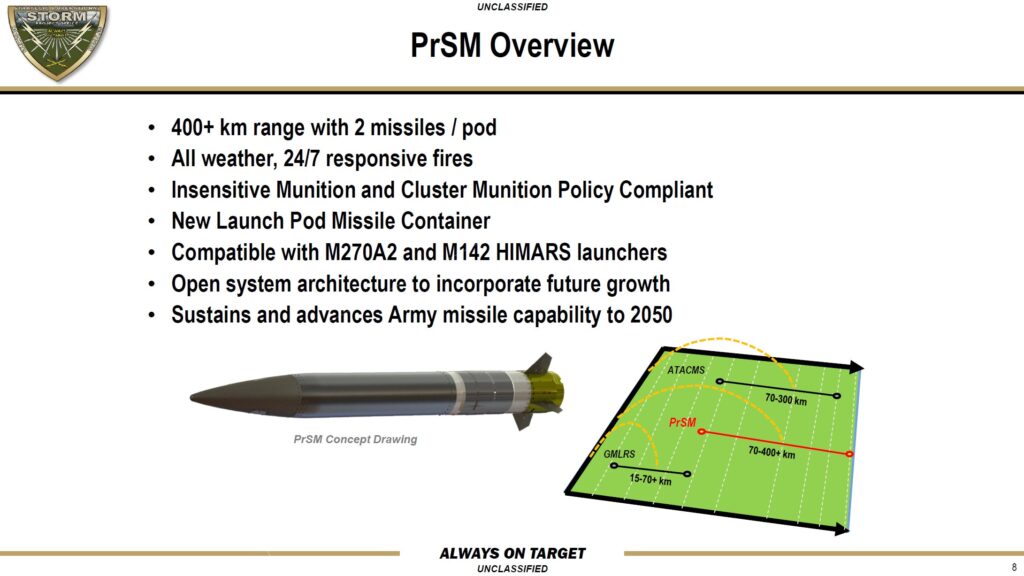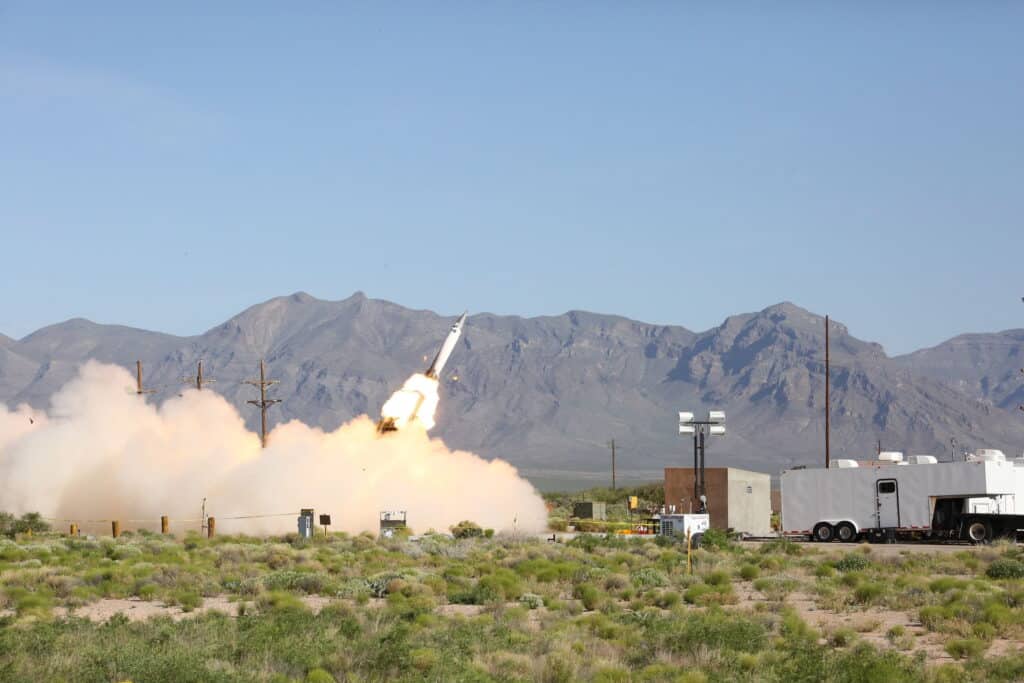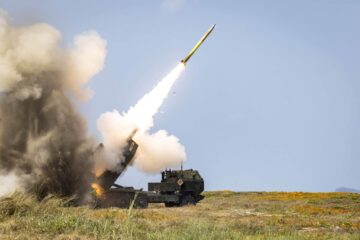Naval News has covered the Precision Strike Missile (PrSM) here.
The Lockheed Martin PrSM has an objective range of 60 to 650 kilometers (37 to 403 miles) and two PrSMs can fit inside a M142 High-Mobility Artillery Rocket System (HIMARS), double the number compared to the MGM-140 Army Tactical Missile System (ATACMS) with the later having a range of 190 miles (305 kilometers).
According to the Association of the United States Army (AUSA), “The PrSM is a surface-to-surface, all-weather, precision-strike guided missile, fired from both the M270A1 Multiple Launch Rocket System (MLRS) and M142 High-Mobility Artillery Rocket System (HIMARS). As the replacement for the MGM-140 Army Tactical Missile System (ATACMS), PrSM doubles ATACMS’ current rate-of-fire with two missiles per launch pod. It is designed to attack threat air defense systems, missile launchers, command and control (C2) nodes, troop assembly/staging areas and high-payoff targets throughout the battlefield at ranges of more than 500 kilometers.”


The U.S. Army’s Long-Range Precision Fires (LRPF) Spokesperson, based at Fort Sill, Oklahoma, replied to Naval News’s inquiry.
Naval News: Do you have any Precision Strike Missile performance dimensions, range, cost, and specifications?
U.S. Army LRPF: “PrSM Increment 1 has consistently demonstrated its capability to have effects well beyond 400 km. The coordinate seeking missile will be a significant increase in range and effectiveness over current ATACMS munitions.”
When asked about the cost in a follow-up email, the LRPF Spokesperson declined to offer specifics on the cost per PrSM missile but said that it is less expensive than ATACMS. The warhead is “an optimized unitary warhead designed to achieve the same effects as ATACMS.” The U.S. Army’s LRPF Spokesperson also could not offer performance specifications at this time regarding missile speed or if PrSM flies faster than ATACMS and the general MLRS rockets.
Naval News: What kind of seeker is used for Anti-Ship purposes?
U.S. Army LRPF: “A multi-mode seeker is used for engaging moving land and maritime targets.”
U.S. Army LRPF declined to offer specifics to a follow-up Naval News email asking what kinds of sensors the multi-mode seeker (thermal, radar, electro-optical TV, LIDAR, etc.) might have.
Naval News: What are the PrSM Increments proposed?
U.S. Army LRPF: “Future Increments of PrSM will include: (1) Multi-domain operations capability to engage moving land and maritime targets; (2) Enhanced lethality payloads capable of autonomously and collaboratively detecting, targeting, and striking high payoff targets that are moving, have moved, poorly located, or dispersed; and (3) Extended range capability enabled through air-breathing ramjet propulsion.”
Naval News: What kind of ramjet is used?
U.S. Army LRPF: “Both solid and liquid fuel ramjet propulsion options are currently being investigated.”
Naval News: What is the fielding and progress status on the Autonomous Multi-Domain Launcher (AML))?
U.S. Army LRPF: “Unmanned HIMARS is participating in Project Convergence 22 and will continue to be matured for fully integrated system level demonstrations in the next several years and may move forward into acquisition at that point.”

Naval News: PrSMs may be able to target moving ships with a new seeker, but can any HIMARS rocket target moving ships with new MLRS rocket seekers—six rockets to a HIMARS—or only PrSM can target moving ships?
U.S Army LRPF: “Currently only PrSM is being designed to engage maritime targets from HIMARS. Each PrSM missile pod will carry two missiles.”

According to the Office of the Undersecretary of Defense, (Comptroller), Chief Financial Officer’s April 2022 Fiscal Year 2023 Budget Request report, “[Precisions Strike Missile] FY 2023 Program: Procures 120 Urgent Materiel Release missiles with Launch Pod Missile Containers and tooling investments to increase production in the future.”


Naval News and Author’s Comments

Although the PrSM is being developed by the U.S. Army’s LRPF Team, the U.S. Marine Corps (USMC) also use the M142 HIMARS so having PrSMs with Land-Based Anti-Ship Missile (LBASM) capabilities is a huge game changer and force multiplier for the Marine Corps.
The HIMARS launcher can rotate 90-degress from center axis to target threats on both sides of the FMTV truck, and the manned M142 HIMARS can be fitted with a rooftop swingarm 7.62mm M240 medium machine gun for close-in area and point defense.
For speculative discussion purposes, PrSM on HIMARS can operate in tandem with the new Navy Marine Expeditionary Ship Interdiction System (NMESIS). NMESIS carries two stealthy 100 nautical miles (114 miles/185 kilometers) Naval Strike Missiles (NSM) on an unmanned 4×4 Joint Light Tactical Vehicle (JLTV) truck that can be sling-loaded by a USMC CH-53K “King Stallion” helicopter for more austere field conditions, mobility, and flexibility. M142 HIMARS (and the unmanned AML) can be transported internally via Marine KC-130J “Hercules” military cargo aircraft and thus requires a landing strip.
Combined, NMESIS with NSM, and HIMARS with PrSM, can form the foundational basis for the USMC’s LBASM deterrent. (Also note that the M142 HIMARS can also be outfitted with special racks for AIM-120 AMRAAMs for a forward surface-to-air missile Air Defense option, but the USMC has yet to field this option although there was a test firing of an AIM-120 from a HIMARS in March 2009).
Thus, U.S. Marine Corps HIMARS can, in theory and test fire practice, attack moving enemy land, ship, and air targets and create a Navy/Marine Anti-Access/Area Denial space over land and sea where HIMARS and NMESIS are stationed. (The HIMARS will still need an independent external sensor to detect and pass on targeting information to the HIMARS launcher. The NMESIS Naval Strike Missile can also attack land targets, providing the U.S. Marines much needed organic LRPFs on land since the divestment of their M1A1 Main Battle Tanks).
With the unmanned AML HIMARS and unmanned NMESIS JLTV, the U.S. Marines can station and conceal these missile launchers at remote positions and control them via satellite from ship, USMC rotary airborne platforms, or distant land locations to avoid counter-battery fire, and move them via remote-control for true unmanned “shoot and scoot” operations. Furthermore, HIMARS with PrSM can, in theory, offer U.S. Navy amphibious warships an ad-hoc LRPF land attack and LBASM moving target capability fired from the deck of amphibious vessels.
PrSM HIMARS can be chained to the flight deck for a visible deterrent, or concealed in the hangar and then brought up to the flight deck by aircraft elevators (for LHA and LHD carriers), and can provide these amphibious ships with no inherent Mark 41 Vertical Launch System (VLS) a huge offensive and self-defensive punch out to 650 kilometers (403 miles) that doesn’t require a towed trailer such as the Mark 41 VLS derivative in a shipping container with Tomahawk cruise missiles.
At the end of July 2022, Naval News asked retired Marine colonel, Mark Cancian, Senior Advisor to the Center for Strategic Institute Studies (CSIS) for his opinion on the upcoming USMC HIMARS with PrSM.
“The Marine Corps needs a long-range missile to complement the NSMs on NMESIS. That missile could be PrSM or Tomahawk. The problem with NSM is its short range, about 100 [nautical] miles. NSM Launchers must get close to the adversary to be effective, but that will be difficult. Once conflict begins, penetrating that far into an adversary’s defensive zone will be extremely dangerous if not impossible. Deploying that close before conflict begins may not be possible diplomatically.”
Mark Cancian, Senior Advisor to Center for Strategic Institute Studies
At this time, it is too early and unknown if the PrSM and AML will be exported to any U.S. allies.






